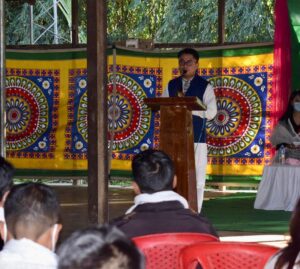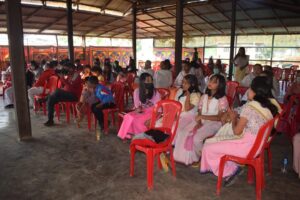Former drug user Ole Wangkhmayum founded the Realise Rehabilitation Centre in Manipur in 2019. He is showing the way for finding a solution to the state’s drug menace
By Yambem Laba
Thirty-year-old Ole Wangkhmayum was an escape artist. Being a chronic drug addict, he had perfected the art of escape from rehabilitation centres. He would pretend to have eyesight problems, ask for treatment outside and make good his escape. He would also befriend the counsellors and after gaining their confidence, run away.

According to Wangkhmayum, his favourite time came whenever there was a storm with thunder and lightning as the sound of him breaking the walls of rehabilitation centres would be inaudible to the watch and ward staff. He escaped from such centres 42 times in total and created a record of sorts. He was on the streets for quite a while, managing his drugs either by selling stolen properties or through friends.
Wangkhmayum would sleep on the roadside and not go home. He also spent six months in the psychiatric ward of the state hospital for treatment, but nothing seemed to work. On the way to a new rehab centre, he used to be tied up with coconut twining on his limbs and galvanised iron wires on his toes, thereby leaving him with no chance of escape.
Then seven years ago, Wangkhmayum had a sudden “spiritual awakening”. As a man in his mid-twenties, he decided to ensure that no one from the younger generation would succumb to the deadly powder called “Number 4” heroin, which means the fourth phase of refinement of the purest form. Going for prices as high as Rs 3,000 a gram at the time, it was produced in factories run by Khun Sha of the Shan State Army in Myanmar. Sha had a standing militia of 10,000 armed cadres; operating from the Golden Triangle region of Southeast Asia, he accounted for 25 per cent of the world’s heroin production.
Following through with his decision, Wangkhmayum founded the Realize Rehabilitation Centre on 23 March 2019 at an unheard-of place called Khuningthek in Imphal East district with four staff members and 23 clients. In January 2020, he shifted to Mongjam Chingjin in Imphal East in an estate owned by the late Thangjam Karunamaya Singh, IPS (retired), who founded the “Alcoholics Anonymous” movement in Manipur. Located in a sylvan setting where one can hear deer barking and owls hooting at night, the centre is undisturbed by the sounds of vehicular traffic.
But by the time Wangkhmayum relocated, the drugs scenario had changed radically. There are now more than 60,000 drug addicts in Manipur, with more than 3,000 of them being women. And what used to cost Rs 3,000 a gram is now available for Rs 300 a gram.
The result is a proliferation of opium plantations in the state and emergence of “mobile factories” or semi-settled drug-manufacturing units in what is called “Lilong factories”. They churn out heroin powder, not the “Number 4” pure type, but what in local parlance is called “thum-morok” or a mixture of chili powder with salt. It only costs Rs 300 a gram and has become accessible to all and sundry.

Therefore, it is no longer only children of the high and mighty who are becoming addicts but those from the lower middle class as well. Rickshaw-pullers and mason workers, who earn Rs 500 a day as labourers, spend Rs 300 of that income on drugs, Rs 100 on food and the rest for their transport home.
Thus, the base of the Golden Triangle is broadening and the 60-plus private rehab centres of Manipur do not have the capacity to cope with the increasing numbers of addicts. The average age at which youngsters get addicted has decreased substantially from about 20-21 years when the powder first made its appearance to around 14-15 years with children still in Classes VIII or IX becoming addicts.
The variety of psychotropic substances available in the market has also increased substantially, from “Number 4” heroin to various pharmaceutical drugs including the deadly “WY” tablets. Ever since the Manipur government banned the sale of liquor in 1991, youngsters, who would have otherwise settled for a bottle of beer, started succumbing to drugs in its various forms. The disappearance of the pharmaceutical product, commonly known as “SP” (spasmo proxyvon) tablets, also led to “Number 4” heroin becoming more easily available and pushing up the number of addicts in the state.
There are two types of drug rehabilitation centers in Manipur. The first is run by the Government of India and they are fully funded for a 45-day treatment course. Yet these institutes charge Rs 4,000 a person for their 30 day course of treatment. How they do so is still uncertain but each of their counsellors are given a minimum of Rs 12,000 as fees. On the other hand, private rehabilitation centres used to charge Rs 6,000 a month for every client but because of the pandemic and inflation, it has increased to Rs 8,000 a month. That said, considering the service provided by such centres and the demand for treatment far outstripping supply, their role cannot be easily forgotten.
Wangkhmayum’s Realize Rehabilitation Centre has a management committee headed by myself in my capacity as the former acting chair-person of the Manipur State Human Rights Commission. Also, on its rolls are National Award-winning film actor L Tonthoi as the brand ambassador and women like Lisham Ratna and Sarah Hungyo Ngagom. Leena Keisham handles women drug addicts as she is an experienced nanny and coaxes women addicts to go in for rehabilitation programmes knowing full well that most of them are also commercial sex workers.
There are only two exclusive drug deaddiction and rehabilitation centres for women in Manipur. The staff at the Realize Rehabilitation Centre consists of clinical psychologist, Dr Th Arun, and two medical officers in Dr Loken and Dr Herojeet to cater to the daily medical and psychological requirements of clients.
The counsellors include W Ajitshwor (45), a trained professional in human immunodeficiency virus, or HIV, stigma and drugs programmes, and former addicts Bi l lu Huidrom (44), Laimayum Bikram (39), Ngagnom Bocha (35) and Oinam Priyojit (39).
There is also a programme called “visiting client” whereby a person, after undergoing the three-month course, can come back and stay in a drugs-free environment for five days a week, return home for the weekend and come back again on the Monday.
Pivotal to drugs management are three pillars — the addict, his/her immediate family and the service providers. All said and done, election season in Manipur was bad as intending candidates put money in the pockets of drug addicts. Wangkhmayum’s worst nightmare is, however, festivals because a partially cured addict can relapse during the festivities, especially when it’s Holi or Christmas. He is convinced though, that apart from following the “12-steps” programme, his move to involve the public in finding a solution to the drug menace engulfing Manipur will one day bear fruit.
(The writer is the Imphal-based Special Representative of The Statesman. This article was first published in The Statesman.)
